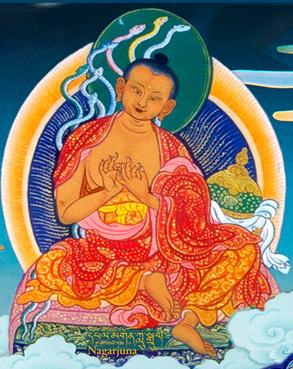Emptiness

Emptiness (Skt. śūnyatā; Tib. སྟོང་པོ་ཉིད་, tongpa nyi, Wyl. stong pa nyid) — the absence of inherent existence in all phenomena, which was explained by the Buddha in the sutras of the second turning of the Wheel of Dharma, and further elaborated upon by masters such as Nagarjuna and Chandrakirti.
Sogyal Rinpoche says:
- "Unfortunately, the word ‘emptiness’, which is used to translate the Sanskrit term shunyata, carries a connotation of a nothing-ness, or a void. Happily, there is a wonderful definition in Tibetan that captures its true meaning: Tib. རྟག་ཆད་དང་བྲལ་བ་, tak ché dang dralwa, which translates as: ‘free from permanence and non-existence'.
- Generally, all philosophies tend to fall into one of two extremes: ‘eternalism‘: believing in the existence or permanence of something, or ‘nihilism‘: believing in non-existence. Shunyata goes beyond both of these extremes, because it is neither permanent nor non-existing, and that is, ultimately, how things are."
The Analogy with Space
Shunyata is often compared to space, which is defined in Buddhism as the complete openness, or 'unobstructedness', which allows anything to occur. Likewise, because reality is 'empty' and not fixed in any way, it is said that anything is possible. As Nagarjuna said:
- To whomever emptiness is possible,
- All things are possible.
Synonyms
There are many synonyms for emptiness. As it says in Distinguishing the Middle from Extremes:
- Emptiness, in short, has these synonyms:
- Suchness, authentic limit of reality,
- Absence of marks, absolute,
- And dharmadhatu. [I.14]
In his commentary to this verse, Mipham Rinpoche explains that emptiness is called “suchness” because it does not change into anything else; just as it was before, so it remains after. Likewise, it is called “authentic limit of reality” because it is the authentic, unmistaken way entities are. It is called “the absence of marks” because the nature of emptiness is the cessation of all marks of conceptual elaboration. It is called the “ultimate truth” because it is the sphere that the sacred wisdom of the noble ones engages in. It is called the “dharmadhatu“ because it is by observing this that all the qualities of the path arise, and so it is the space (dhatu), or the cause, of all noble qualities.
Subdivisions
The Emptiness of Emptiness
Nagarjuna does not put forward emptiness as another view about reality. In fact, he says:
- The victorious ones say that emptiness
- Undermines all dogmatic views,
- Those who take a dogmatic view of emptiness
- Are said to be incurable.
And:
- I prostrate to Gautama,
- Who, out of compassion,
- Taught the sacred Dharma
- That leads to the relinquishing of all views.
Alternative Translations
- great emptiness
- voidness—an absence of an impossible way of existing (Alexander Berzin).
Oral Teachings Given to the Rigpa Sanhga
- Sogyal Rinpoche, Winterberg, Germany, 30 October 2014
- Sogyal Rinpoche & Patrick Gaffney, Lerab Ling, 6-12 August 2016
- Tsoknyi Rinpoche, Lerab Ling, 3 August 2018
Edited Teachings of Sogyal Rinpoche
- Rigpalink January 2010, 'The View of Shunyata - part 2', Lerab Ling, 26 September 2008; Barcelona 10 & 11 October 2009 (available in English, French, German and Spanish, ordernumber 731)
- Rigpalink December 2009, 'The View of Shunyata - part 1', Lerab Ling, 13 August 2009; Barcelona, 10 October 2009 (available in English, French, German and Spanish, ordernumber 730)
- Rigpalink June 2000, 'Shunyata – The Nature of Reality', Paris, 19 April 2000 (available in English, French, German, ordernumber 321)
Further Reading
- A Treasury of Dharma, aka The Mengak Study Pack (Lodève: The Tertön Sogyal Trust, 2005), pages 68-74.
- Khenpo Tsultrim Gyamtso Rinpoche, Progressive Stages of Meditation on Emptiness (Auckland: Zhyisil Chokyi Ghatsal Publications, 2001).
- Thinley Norbu, The Small Golden Key (Shambhala Publications, 1999), ‘7. Great Emptiness'.